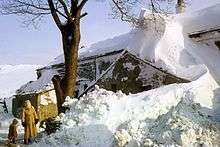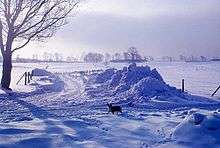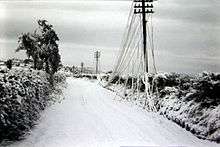Winter of 1962–63 in the United Kingdom



The winter of 1962–63 (also known as the Big Freeze of 1963) was one of the coldest winters on record in the United Kingdom.[1] Temperatures plummeted and lakes and rivers began to freeze over.
In the Central England Temperature (CET) record, extending back to 1659, only the winter (defined as the months of December, January and February) of 1683–84 has been significantly colder, with 1739–40 being slightly colder than 1962–63. Over Scotland and Northern Ireland, where data does not extend back to 1740,[a] the winters of 1813–14 and 1878–79[2] were certainly colder than 1962–63, as was the winter of 1779–80 in Scotland and 1894–95 in Northern Ireland.[3]
This winter remains the coldest since at least 1895 in all meteorological districts of the United Kingdom except Scotland North, where the two winters of 1978–79 and 2009–10 were marginally colder.[4]
December 1962
The beginning of December was very foggy, with London suffering its last great smog before clean air legislation and the reduction in the use of coal fires had their full effect. A short wintry outbreak brought snow to the country on 12–13 December. A very cold easterly set in on 22 December as an anticyclone formed over Scandinavia, drawing cold continental winds from Russia. Over the Christmas period, the Scandinavian High collapsed, but a new one formed near Iceland, bringing northerly winds. Significant snowfall occurred as the air mass moved south and parts of Southern England in particular had heavy snow late on 26 December (Boxing Day) continuing into 27 December.[5] The cold air became firmly established.
29 and 30 December 1962
On 29 and 30 December 1962 a blizzard swept across South West England and Wales. Snow drifted to over 20 feet deep in places, driven on by gale force easterly winds, blocking roads and railways. The snow stranded villagers and brought down powerlines.[5] The near-freezing temperatures meant that the snow cover lasted for over two months in some areas. Snow lay to 6 inches depth in Manchester city centre, 9 inches in Wythenshawe, and about 18 inches at Keele University in Staffordshire. By the end of the month, there were snow drifts 8 feet deep in Kent and 15 feet deep in the west.
January 1963
With an average temperature of −2.1 °C (28.2 °F),[6] January 1963 remains the coldest month since January 1814 over Central England,[b] although over Northern England,[7] Scotland[8] and Northern Ireland[9] February 1947 was generally colder, while December 2010 was also colder over Northern Ireland. Much of England and Wales was snow-covered throughout the month.[5] The country started to freeze solid, with temperatures as low as −19.4 °C (−2.9 °F) at Achany in Sutherland on the 11th. Freezing fog was a hazard for most of the country.[10]
In January 1963 the sea froze for a mile out from shore at Herne Bay, Kent.[11][12] The sea also froze inshore in many places, removing many British inland waterbirds’ usual last resort of finding food in estuaries and shallow sea. The sea froze 4 miles out to sea from Dunkirk, and BBC Television news expressed a fear that the Strait of Dover would freeze across.[5] The upper reaches of the River Thames also froze over,[10][13] though it did not freeze in Central London, partly due to the hot effluent from two thermal power stations, Battersea and Bankside; the removal of the old multi-arched London Bridge, which had obstructed the river’s free flow, and the addition of the river embankments, made the river less likely to freeze in London than in earlier times (see River Thames frost fairs). On 20 January, 283 workers had to be rescued by RAF helicopters from Fylingdales, where they had been snowbound for several days.[5][14] The ice was thick enough in some places that people were skating on it,[5] and on 22 January a car was driven across the frozen Thames at Oxford.[5][14] Icicles hung from many roof gutterings; some of these were over 3 feet long.
Starting on 25 January there was a brief thaw but it only lasted 3 days. [15]
February 1963
In February 1963, more snow came. It was also stormy with winds reaching Force 8 on the Beaufort scale (gale-force winds).
A 36-hour blizzard caused heavy drifting snow in most parts of the country. Drifts reached 20 feet in some areas and there were gale-force winds reaching up to 81 mph. On the Isle of Man, wind speeds were recorded at 119 mph.
March 1963
The thaw set in during early March; 6 March was the first morning of the year without any frost anywhere in Britain. The temperatures soon soared to 17 °C (62.6 °F) and the remaining snow rapidly disappeared.
Effect on sport
One of the most noticeable consequences of the freezing conditions which hit the UK in the winter of 1962–63 was the enormous disruption to the national sporting calendar. For many weeks football matches in both the English and Scottish leagues suffered because of the severe effects of the winter weather.[1] Several ties in the 1962–63 FA Cup were rescheduled ten or more times, to the point that the 5th and 6th rounds originally scheduled for 16 February and 9 March respectively, were finally played on 16 March and 30 March respectively, with the semi-finals rescheduled from 30 March to 27 April. A board known as the Pools Panel was set up; postponed matches were adjudicated by it, to provide the football pool results. From 8 December to 16 February, Bolton Wanderers played no competitive matches.[16] Both codes of rugby, union and league, suffered much the same fate.[17] All this occurred in the days well before under-soil heating became widespread at major venues. When the thaw arrived, a huge backlog of fixtures had to be hastily dealt with. The Football League season was extended by four weeks from its original finishing point of 27 April, with the final league fixtures (scheduled sports events) taking place one day before the rescheduled FA Cup Final. Some lower-level competitions did not complete their season at all.
National Hunt horse racing was also badly affected, with 94 meetings cancelled during the freeze. There was no racing in England between 23 December and 7 March inclusive, although a meeting at Ayr in Scotland went ahead on 5 January.[18]
In popular culture
The cold of the winter of 1962–63 is alluded to in the Dream Academy's 1985 hit single "Life in a Northern Town": "In winter 1963 / It felt like the world would freeze / With John F. Kennedy and the Beatles". However, the events referenced i.e. the assassination of John F. Kennedy, which took place in November 1963 and Beatlemania in the United Kingdom also initially observed in 1963, mean they took place the following winter of 1963–64.
The 2017 Christmas special and first episode of series seven of Call the Midwife were set during the winter of 1962–63. The cold was a factor in several of the episodes' plot points.[19] Actress Jenny Agutter, who plays Sister Julienne, wrote an article in The Times about her memories of that winter to coincide with the Christmas special.[20]
See also
Notes
a The oldest instrumental climatic data for Scotland are from Edinburgh in 1764, and for Northern Ireland from Armagh in 1796.
b Over the UK as a whole February 1947 was 0.2 °C (0.36 °F) colder than January 1963. The months of February 1895, January 1881 and February 1855 were probably colder than January 1963 when averaged over the entire UK, though precise data have never been compiled.
References
- 1 2 "BBC London summary".
- ↑ Burt, Stephen; ‘The bitter winter of 1962/63’; p. 23
- ↑ Shellard, H.C.; ‘The Winter of 1962-63 in the United Kingdom – A Climatological Survey’; Meteorological Magazine; 97(1150), May 1968, pp. 129-141
- ↑ Scotland North Mean Temperatures
- 1 2 3 4 5 6 7 A BBC television programme made in 1963 and retransmitted on BBC2 at 5.30–6.30 pm on Saturday 19 January 2013
- ↑ Eden, Philip (1995). Weatherwise. Macmillan. p. 297, citing Gordon Manley’s Central England Temperature Series. ISBN 0-333-61610-3.
- ↑ England North mean temperatures
- ↑ Scotland Mean Temperatures
- ↑ Northern Ireland Mean Temperatures
- 1 2 "Pathe news reel, January 1963".
- ↑ "Newsreel film clip of sea frozen at Herne Bay".
- ↑ "Frozen sea reported as damaging pier at Herne Bay".
- ↑ "photographs of Thames frozen at Windsor".
- 1 2 Paul Simons, The Times, 26 January 2013, p 73
- ↑ https://www.youtube.com/watch?v=pMXxRcqmrkQ
- ↑ http://www.footballsite.co.uk/Statistics/Articles/1962-63winter.htm football site: 1962/63 – a Winter of postponements
- ↑ "Rugby affected. Extraordinary measures for a single match". BBC News. 18 February 2003.
- ↑ Kettley, John (2009). Weatherman. Great Northern Books. p. 35. ISBN 978-1-905080-61-8.
- ↑ "Call the Midwife: the real history behind the Big Freeze of 1963". Radio Times. 2 May 2018. Retrieved 6 May 2018.
- ↑ Agutter, Jenny (23 December 2017). "Jenny Agutter remembers the Big Freeze that inspired Call the Midwife". The Times. Retrieved 6 May 2018.
- General
- L.P. Smith, Seasonable Weather, George Allen & Unwin Ltd, 1968, p133
- The winter of 1962/63
- Another summary page
External links
Video links
- Winterwatch episode on YouTube featuring the 10 February 1963 Tonight episode "The Big Freeze"[1]
- BFI documentary about snow and the railways
- BBC World Service Radio Report New Years Eve 1962
- Pathe newsreel, February 1963, snow affecting railway in kent
- Pathe newsreel, January 1963, athletics
- Pathe newsreel, January 1963, helicopter feeding livestock